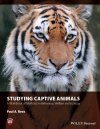About this book
Studying Captive Animals outlines the methods that may be used to study the behaviour, welfare and ecology of animals living under the control of humans, including companion animals, feral populations, and those living on farms and in zoos. Studying Captive Animals is a step-by-step guide to the whole process of conducting a scientific study: from designing the original project, formulating testable hypotheses, and collecting and analysing the data, to drawing conclusions from the work and writing it up as a scientific report or paper. It also illustrates how to write a formal research proposal – a crucial and often difficult element of the student project – and how to deal with the ethical review process. Sample data collection sheets are provided and the analysis and presentation of data are worked through in diagrammatic form. In addition, exercises are included that enable the reader to practice analysing different types of data and advice is provided on the selection of appropriate statistical tests.
The text describes the different types of student projects that may be undertaken in the field, and explains where secondary data may be found for zoos. This is an insightful resource, particularly for those studying and working with zoo and farm animals. It is essential reading for students studying zoo biology and animal management; it is also suitable for students on courses in animal behaviour, animal welfare, zoology, biology, psychology, animal science, animal production, animal ecology, conservation biology, and veterinary science. Studying Captive Animals is primarily intended for undergraduates but will also be of value to postgraduate students who have not previously engaged in field studies. Professionals working in institutions that are members of the World Association of Zoos and Aquariums, the European Association of Zoos and Aquaria and other regional and national zoo organisations will benefit from access to this practical guide.
Contents
Concise table of contents:
Acknowledgements xiii
About the Companion Website xv
Preface xi
1. Studies of Behaviour, Welfare and Ecology in Captive Animals 3
2. Designing Your Study 19
3. Equipment 63
4. Identifying Individuals and Recording Behaviours 77
5. Activity Budgets and Welfare 103
6. Measuring Social Behaviour 125
7. Enclosure Use, Habitat Selection and Feeding Ecology 163
8. Population Studies 181
9. How to Analyse Your Data – Statistics 211
10. How to Write a Report 245
Appendix 267
References 269
Further Reading 287
Index 289
Detailed table of contents:
Preface xi
Acknowledgements xiii
About the Companion Website xv
Part 1 Introduction 1
1. Studies of Behaviour, Welfare and Ecology in Captive Animals 3
1.1 What Are Captive Animals? 4
1.1.1 Introduction 4
1.1.2 A Short and Incomplete History of Captive Animal Studies 4
1.2 Types of Studies 8
1.2.1 Behaviour Studies 8
1.2.2 Animal Welfare Studies 10
1.2.3 Ecological Studies 10
1.3 Possible Study Locations 11
1.4 Advantages and Disadvantages of Studying Captive Animals 11
1.5 What Types of Research Have Been Conducted on Animals Living in Zoos? 13
1.6 What Sort of Study Should I Undertake? 16
2. Designing Your Study 19
2.1 Introduction 20
2.2 Selecting Subjects for Study 20
2.2.1 Selecting a Species 20
2.2.2 Simple vs Complex Zoo Environments: Choosing the Right Enclosure 20
2.2.3 Specialised Zoo Facilities for Studying Animals 25
2.3 How Does Science Work? 25
2.4 Experimental Design 29
2.4.1 Introduction 29
2.4.2 Controlling Subject Variables 30
2.4.3 Controlling Situational Variables 32
2.4.4 Confounding Variables 32
2.4.5 The Link Between Experimental Design and Statistics 32
2.4.6 Cross ]Sectional and Longitudinal Studies 32
2.5 Data Collection 33
2.5.1 Who Should Collect the Data? 33
2.5.2 Sampling 34
2.5.3 Replication: How Many Subjects Should be Studied? 35
2.5.4 Pseudoreplication 35
2.5.5 Accuracy and Reliability of Data 35
2.5.6 Inter ]Observer Reliability 36
2.5.7 Observer Drift 37
2.5.8 Can Untrained Observers be Used to Collect Behavioural Data? 38
2.5.9 Collecting Data Using Questionnaires 39
2.6 Keeper/Trainer Assessments of Animals 42
2.7 Pilot Studies 42
2.8 Making Observations 43
2.8.1 What to Wear and How to Behave 43
2.8.2 Vantage Points, Camouflage and Screening 43
2.9 Submitting a Research Proposal 45
2.9.1 Introduction 45
2.9.2 Zoo Research Departments 47
2.9.3 Ownership of Research Data 47
2.10 Some Problems Associated with Working in Zoos 47
2.10.1 Working in the Zoo Environment 47
2.10.2 Interspecies Interactions and Mixed Species Exhibits 54
2.11 Legislation 55
2.11.1 Ethical and Legal Considerations 55
2.11.2 Does Your Study Need a Licence? 57
2.12 Risk Assessment and Health and Safety Considerations 58
2.12.1 Insurance 59
2.12.2 Hazardous Animal Categorisation 59
3. Equipment 63
3.1 Introduction 64
3.2 Binoculars 64
3.2.1 Choosing Binoculars 64
3.2.2 The Dioptre Adjustment 66
3.3 Voice Recorders 67
3.4 Personal Digital Assistants (PDAs) 68
3.5 Still Cameras 68
3.5.1 Camera Traps 68
3.6 Digital Video Cameras 70
3.7 Event Recorders 70
3.8 Trail Monitors 71
3.9 Accelerometers 71
3.10 GPS and GIS 71
3.11 Radio Collars 73
3.12 Data-Loggers 73
3.13 Proximity Data ]Loggers 73
3.14 Radio Frequency Identification (RFID) Technology 74
3.15 Too Much Equipment? 74
Part 2 Measuring Animal Behaviour and Welfare 75
4. Identifying Individuals and Recording Behaviours 77
4.1 Identifying and Naming Individual Animals 78
4.1.1 Identification 78
4.1.2 Naming Individuals 82
4.2 Describing and Interpreting Behaviour 83
4.2.1 Using Drawings to Illustrate Behaviour 83
4.2.2 What is an Ethogram? 83
4.2.3 Constructing an Ethogram 85
4.2.4 How Many Behaviours? Behaviour Discovery Curves 86
4.3 Interpreting Behaviours 87
4.3.1 Establishing the Meaning and Purpose of a Behaviour 87
4.3.2 Gestures and Vocalisations 90
4.4 How Can Behaviour be Measured? 90
4.5 How to Sample and Record Behaviour 92
4.5.1 Introduction 92
4.5.2 Recording Rules 95
4.5.3 Sampling Rules 97
4.6 When Should Samples be Taken? 101
4.7 Recording Behaviour in the Field 102
4.7.1 Behaviour Record Sheets 102
4.7.2 Recoding on an iPhone 102
5. Activity Budgets and Welfare 103
5.1 Introduction 104
5.1.1 Indirect Measures of Welfare 105
5.2 Activity Budgets 105
5.2.1 Introduction 105
5.2.2 Problems with ‘Invisible’ Animals 107
5.2.3 How Many Samples? 107
5.2.4 Temporal Patterns 108
5.2.5 Stereotypic Behaviour 109
5.2.6 Enrichment Studies 111
5.3 Numerical Rating Scales and Analogue Visual Scales 113
5.4 Body Condition and Welfare 114
5.4.1 Body Condition Scoring 114
5.4.2 Measuring Obesity 115
5.4.3 Computer Monitoring of Welfare 115
5.5 Animal Personality 116
5.5.1 Measuring Personality 116
5.5.2 The Use of Cluster Analysis to Compare the Behaviour of Individuals in a Group 117
5.5.3 Measuring Tameness 119
5.6 Preference Tests 119
5.7 Visitor Studies 120
5.8 The Parasitology of Captive Animals 121
5.9 Exercises 122
6. Measuring Social Behaviour 125
6.1 Introduction 126
6.2 Associations Between Individuals 127
6.2.1 Defining Associates 127
6.2.2 Association Indices 128
6.2.3 Chance Encounters Between Animals 130
6.2.4 Sociograms 135
6.3 Maintenance of Proximity Index (MPI) 139
6.4 Nearest Neighbour Measurements 142
6.5 Relationship Indices 143
6.6 Social Facilitation 143
6.7 Agonistic Behaviours: Aggression and Appeasement 145
6.7.1 Index of Fighting Success 150
6.8 Dominance Hierarchies 151
6.8.1 Constructing a Matrix of Dominance Relationships 152
6.8.2 A Simple Dominance Index 154
6.9 Courtship, Mating and Mate Selection 154
6.9.1 Social Learning of Sexual Behaviour 157
6.10 Exercises 159
Part 3 Measuring Ecology 161
7. Enclosure Use, Habitat Selection and Feeding Ecology 163
7.1 Introduction 164
7.2 Enclosure Size and Use 164
7.2.1 Introduction 164
7.2.2 Spread of Participation Index (SPI) 167
7.2.3 Electivity Index 170
7.2.4 Utilisation of Vertical Space 170
7.2.5 Visibility 173
7.3 Feeding Ecology and Behaviour 175
7.3.1 Gross Assimilation Efficiency and Food Passage Time 177
7.4 Exercises 178
8. Population Studies 181
8.1 Introduction 182
8.2 How Many Animals Are There and How Are They Dispersed? Counting Animals in the Field 183
8.2.1 Use of Transects to Estimate Population Size or Density 183
8.2.2 The Dispersion of Animals 185
8.3 Studies of Population Growth 186
8.3.1 Life Tables and Survivorship Curves 186
8.3.2 Predicting Population Growth 188
8.3.3 Sex Ratio 193
8.3.4 Breeding Potential: Calculating Effective Population Size 194
8.4 Family Histories 195
8.5 Long ]Term Studies of Zoo Populations 196
8.6 National and Global Studies of Zoo Populations 200
8.6.1 Where to Find Secondary Data on Zoo Populations 202
8.7 Exercises 204
Part 4 Statistics and Report Writing 209
9. How to Analyse Your Data – Statistics 211
9.1 Introduction 212
9.1.1 What are Statistics? 212
9.1.2 What is a Variable? 212
9.1.3 Populations and Samples 213
9.2 Descriptive Statistics 214
9.2.1 Graphs 214
9.2.2 Measures of Central Tendency 220
9.2.3 Measures of Dispersion 221
9.3 Types of Distributions 224
9.3.1 Cumulative Frequency Distributions 224
9.3.2 The Normal Distribution 224
9.3.3 The Poisson Distribution 228
9.3.4 The Binomial Distribution 229
9.4 Inferential Statistics 231
9.4.1 Hypotheses and Hypothesis Testing 231
9.4.2 Statistical Significance and Probability 232
9.4.3 One ]Tailed or Two ]Tailed? 233
9.4.4 Degrees of Freedom 234
9.4.5 Type I and Type II Errors 234
9.4.6 Fishing Trips and Statistical Significance – the Bonferroni Correction 235
9.5 Statistical Tests 236
9.5.1 Choosing a Statistical Test 236
9.5.2 Testing Samples for Differences 236
9.5.3 Correlation and Regression 239
9.5.4 Goodness of Fit, Testing for Homogeneity and Contingency Tables 242
9.6 Meta ]Analysis 244
9.7 Statistical Packages – a Warning 244
10. How to Write a Report 245
10.1 Academic Journals 246
10.1.1 What is an Academic Journal? 246
10.1.2 How to Choose a Journal 246
10.1.3 Impact Factors 247
10.1.4 Submitting a Paper for Publication 247
10.1.5 The Peer Review Process 247
10.2 Writing Style 248
10.2.1 Tenses and Voices 248
10.2.2 British vs American English 249
10.2.3 Scientific Names of Animals 249
10.2.4 How to Refer to Individual Animals in Scientific Writing 250
10.3 Writing a Report 251
10.3.1 Structure 251
10.3.2 Choosing a Title 251
10.3.3 Authors and Affiliations 254
10.3.4 Abstract 254
10.3.5 Introduction/Literature Review 255
10.3.6 Methods 256
10.3.7 Results 258
10.3.8 Discussion 259
10.3.9 Acknowledgements 259
10.3.10 Summary 259
10.3.11 References 259
10.4 Referencing the Work of Others 260
10.4.1 Referencing Systems 260
10.4.2 The Vancouver System 260
10.4.3 The Harvard System 260
10.4.4 Referencing Software 265
Appendix 267
References 269
Further Reading 287
Index 289
Customer Reviews
Biography
Dr. Paul A. Rees is a Senior Lecturer in the School of Environment and Life Sciences at the University of Salford where he teaches zoo biology and wildlife law. He previously taught a wide range of subjects including biology, psychology and environmental science in a number of colleges in the UK and was formerly Senior Lecturer in Ecology at the Sokoto College of Education, Nigeria. Dr Rees conducted research on feral cats for his PhD, funded by the Royal Society for the Prevention of Cruelty to Animals, and has a long standing interest in large mammals, especially the ecology, behaviour and conservation of elephants. He once worked as an elephant keeper.







































